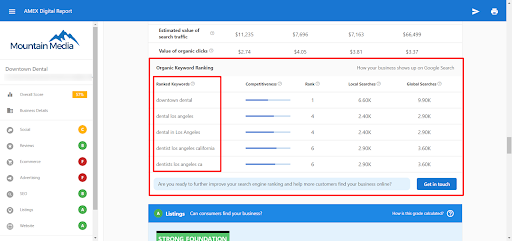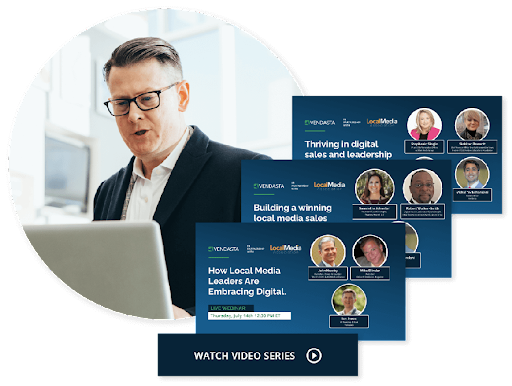Understanding Inbound Lead Generation and the Strategies That Convert
For a digital agency, inbound lead generation skills are critical to success. They help you generate new leads for your own business as well as your clients' businesses.
Become a trusted expert to your clients in the field of local SEO. Download “How to conquer local search engine optimization (SEO): The comprehensive guide” right now.
While the digital landscape changes constantly, the concepts behind inbound lead generation are consistent—learn more about these strategies below.
What is inbound lead generation?
Inbound lead generation is an umbrella term for marketing strategies that help consumers find the goods and services they’re interested in. Businesses use these tactics, including content marketing, social media marketing, and search engine optimization, to drive brand awareness and show up online for consumers or other businesses at the right time.
How does inbound lead generation work?
This digital marketing strategy aims to attract the attention of the target audience—people who are already actively looking for relevant goods and services. Inbound marketing does this by creating content that resonates with the target audience, inviting potential clients and customers to connect with the brand and open a line of two-way communication.
Key components of these strategies include:
- Search engine optimization that ensures a business's website or services show up for relevant keyword searches.
- Conversion rate optimization, which helps increase the chance that someone who lands on a business's page takes further action—up to and including making a purchase.
- Content marketing, which includes publishing content on websites and social media as well as email.
- Marketing research that supports an understanding of the target audience, competitive landscape, and overall market.
Types of inbound lead generation
Your marketing agency strategy should include multiple lead generation types. That's true whether you're working to start a digital marketing agency or provide quality lead generation for clients.
Content marketing
Content has been the king of digital marketing in one way or another for decades—and for a reason. Creating content that resonates with and provides value for the target audience positions you or your clients as:
- Authorities. Expert, trustworthy content helps overcome consumer biases and build relationships with potential clients.
- Helpful and caring. When you work to provide content your target audience wants or needs, you demonstrate that you care about their outcomes.
- Able to meet client needs. Content marketing lets you offer a sneak peek at services and abilities, providing some proof that a client is making the right choice.
One great thing about content marketing is that you can scale this offering to clients without doing all the work in-house. Around 50 percent of marketing professionals outsource at least some of their content creation (Search Engine Journal).
Social media marketing
On average, people spend more than two hours per day on social media (Forbes). You can leverage these platforms to connect with audiences that are already there—it's a powerful opportunity to create brand awareness and build community.
Social media marketing is powerful enough that some successful boutique marketing agencies concentrate solely on this inbound lead-generation task. However, more comprehensive agencies can white-label products and services to create efficient social media management services through the use of AI and automation tools.
Search engine optimization (SEO)
Any marketing consultancy business must understand SEO well, which refers to on-page and off-page work to increase site and page rankings. SEO aims to help content show up for the right keywords and searcher intent.
Components of SEO services can include:
- Keyword research. Marketing organizations face a constant need to review keyword trends and update copy to ensure optimal SEO performance.
- Competitor analysis. Understanding the competitive landscape can help you create SEO content that beats competitors in search engine results pages (SERPs).
- Gap analysis. Analyzing potential gaps in what type of content is served to the target audience can help you identify low-hanging SEO fruit that drives fast improvements in SERP rankings.
- Technical on-page SEO. Technical elements, such as page speed, user influence, and how content is marked up, influence SEO performance.
- Link building. When credible pages link back to your or your clients' sites, the search engines see this as a sort of recommendation. A high number of credible links can be helpful for SEO.
Email marketing
If email content and campaigns aren't among your marketing agency services, you could be leaving revenue on the table. Email remains a tried-and-true digital marketing method with potential returns of 400 percent or more (or $4 for every $1 spent).
Even so, email still challenges a lot of organizations. More than 90% of marketers who use generative AI to help create emails say this tactic is effective (HubSpot). Yet, almost 60% of Americans say that they receive many emails that aren't useful (Edison Mail). This disparity is a gap that experienced agencies can step into, helping clients overcome email marketing obstacles to reach their audiences more effectively.
Webinars and events
Webinars and events are oft-overlooked but powerful lead generation strategies. Webinar landing page conversion rates can be impressively high, with some reaching 51% (Luisa Zhou). These opportunities also provide the chance to connect with highly invested potential clients face-to-face or, at least, in a more personal manner than is possible with other inbound techniques.
You can also scale webinar and event efforts by reusing this content. You can record presentations at live events to offer later as a webinar, for example, or create video snippets from these events to use on social media.
Benefits of inbound lead generation
The benefits of inbound lead generation impact marketing performance and the bottom line for digital agency startups as well as established agencies serving numerous clients. Common benefits include:
- Cost savings. Inbound leads generally cost less than those generated by traditional outbound efforts. You can also customize campaigns and approaches to meet client budgets. For example, you can launch social media ad campaigns with $100 a month to start and scale up as you go, which is not an option with most traditional ad formats.
- Better quality leads. Inbound techniques work on the assumption that the people who find goods or services are already somewhat interested in them. Someone has engaged in online behavior that suggests they might be interested in an ad or has actively searched for a company or product. This level of interest makes it easier to convert the lead.
- Building trust with the audience. Content and other tactics involved in inbound lead generation are designed to build trust and credibility with potential customers, increasing the chances of future conversions. This is especially true when marketing teams put efforts into authenticity and storytelling.
- Flexibility. Because so many channels exist for inbound lead generation, you can create truly custom-tailored approaches for each client, taking into account factors such as brand identity, business goals, and audience needs.
Challenges of inbound lead generation
For all its benefits, inbound marketing lead generation is not without challenges. It requires time, effort, and agency skills to drive results, and the best practices for how to find clients and convert leads evolve constantly.
The increasingly crowded digital landscape means more competition by the day, so agencies must work to remain knowledgeable on current best practices and ahead of the market in their niche.
Tips and tricks for inbound lead generation
If you want to start a digital marketing agency or increase your success with agency ownership, following some current best practices for inbound lead generation is important. Start with the tips below.
- Create buyer personas. Always understand your target audience. Work with each client to create buyer personas to support accurate, targeted messaging.
- Develop content marketing strategies. Create a content marketing plan for each client that's backed by SEO relevance. Consider what keywords and searcher intents you might target and when and how you should publish content. You might also consider existing content for client brands and whether it can be refreshed or repurposed for added value.
- Optimize websites. Ensure websites are properly optimized to support performance in the SERPs, but don't just create content and pages for the machines. Ensure sites support optimal human user experience and conversion rates.
- Use social media effectively. With so many popular social media apps available, brands can't always effectively support everyone. Consider where the target audience is, the client's preferences and style, and the nature of the message. Then, choose a few social media platforms for consistent lead-generation tactics.
- Implement lead nurturing and scoring techniques. Analyze leads, including where they come from, how much they cost, and whether they convert. Make tweaks to your processes to increase the quality of your leads as well as the quantity.
If you’re ready to grow your digital marketing agency, consider tapping into some of the best niches for marketing agencies using the inbound lead generation tactics discussed in this article.




